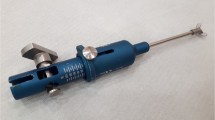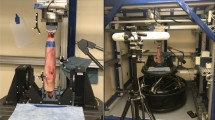Abstract
Purpose
Instability of the proximal tibiofibular joint (PTFJ) can be treated with bicortical suspension (BCS) fixation. However, the ideal location, orientation, and configuration to apply one or two BCS devices are not clear.
Methods
A finite-element model of the PTFJ was created from a female adult’s CT dataset. Anterior and posterior ligaments at the PTFJ were modeled and suppressed to simulate stable and unstable joints. Fifty-six models simulated 56 device placements along guiding tunnel lines that connect eight entry locations on the fibular head to seven exit points on the anteromedial tibia. Doubling device stiffness created 56 more models. Combing any two placements created 1176 double-device configurations which were categorized to be crossed, divergent or parallel. Displacement of the fibular head relative to the fixed tibia under 100 N anterolateral and posteromedial forces was assessed.
Results
Different placements had 2.1–27.9 mm translation with 0.7–8.9° internal rotation under anterolateral loading, and 1.8–5.2 mm translation with 6.1–7.9° external rotation under posteromedial loading. More transverse and superior orientations were associated with smaller anterolateral translation; more posterior and superior entry locations were associated with smaller internal rotation. The median (IQR) reductions in anterolateral translation by doubling device stiffness and by adding a second device were 0.8 (IQR 0.5–1.0) and 0.8 (IQR 0–6.1) mm, respectively. The type of double-device configurations had no significant effect on fibular motion.
Conclusion
Surgeons should drill the guiding tunnel superiorly and transversely to ensure the optimal restoration of the PTFJ anterolateral stability.





Similar content being viewed by others
Data, materials, and/or code availability
The raw and result data for this study are huge (at least 1GB). So, it is not suitable for sharing publicly. But it can be accessible if requests are made to the authors.
References
Ackerman MJ (2022) The visible human project. Stud Health Technol Inform 288:134–140
Anavian J, Marchetti DC, Moatshe G, Slette EL, Chahla J, Brady AW et al (2018) The forgotten joint: quantifying the anatomy of the proximal tibiofibular joint. Knee Surg Sports Traumatol Arthrosc 26:1096–1103
Cunningham NJ, Farebrother N, Miles J (2019) Review article: Isolated proximal tibiofibular joint dislocation. Emerg Med Australas 31:156–162
Espregueira-Mendes JD, da Silva MV (2006) Anatomy of the proximal tibiofibular joint. Knee Surg Sports Traumatol Arthrosc 14:241–249
Fedorov A, Beichel R, Kalpathy-Cramer J, Finet J, Fillion-Robin JC, Pujol S et al (2012) 3D Slicer as an image computing platform for the Quantitative Imaging Network. Magn Reson Imaging 30:1323–1341
Jabara M, Bradley J, Merrick M (2014) Is stability of the proximal tibiofibular joint important in the multiligament-injured knee? Clin Orthop Relat Res 472:2691–2697
Kruckeberg BM, Cinque ME, Moatshe G, Marchetti D, DePhillipo NN, Chahla J et al (2017) Proximal tibiofibular joint instability and treatment approaches: a systematic review of the literature. Arthroscopy 33:1743–1751
Liacouras PC, Wayne JS (2007) Computational modeling to predict mechanical function of joints: application to the lower leg with simulation of two cadaver studies. J Biomech Eng 129:811–817
Maas SA, Ellis BJ, Ateshian GA, Weiss JA (2012) FEBio: finite elements for biomechanics. J Biomech Eng 134:011005
Magnusson EA, Telfer S, Parker K, Hagen M, Githens M, Firoozabadi R (2021) The effect of proximal tibiofibular joint dislocation on knee mechanics: reduction and fixation matters. Eur J Orthop Surg Traumatol. https://doi.org/10.1007/s00590-021-03047-4
Marchetti DC, Moatshe G, Phelps BM, Dahl KD, Ferrari MB, Chahla J et al (2017) The proximal tibiofibular joint: a biomechanical analysis of the anterior and posterior ligamentous complexes. Am J Sports Med 45:1888–1892
McNamara WJ, Matson AP, Mickelson DT, Moorman CT 3rd (2018) Surgical management of proximal tibiofibular joint instability using an adjustable loop, cortical fixation device. Arthrosc Tech 7:e271–e277
Minns RJ, Hunter JA (1976) The mechanical and structural characteristics of the tibio-fibular interosseous membrane. Acta Orthop Scand 47:236–240
Najibi S, Banglmeier R, Matta J, Tannast M (2010) Material properties of common suture materials in orthopaedic surgery. Iowa Orthop J 30:84–88
Ogden JA (1974) Subluxation and dislocation of the proximal tibiofibular joint. J Bone Jt Surg Am 56:145–154
Oksum M, Randsborg PH (2018) Treatment of instability of the proximal tibiofibular joint by dynamic internal fixation with a suture button. Arthrosc Tech 7:e1057–e1061
Parker AS, Beason DP, Slowik JS, Sabatini JB, Waldrop NE 3rd (2018) Biomechanical comparison of 3 syndesmosis repair techniques with suture button implants. Orthop J Sports Med 6:2325967118804204
Pena E, Calvo B, Martinez MA, Doblare M (2007) Effect of the size and location of osteochondral defects in degenerative arthritis. A finite element simulation. Comput Biol Med 37:376–387
Pessoa P, Alves-da-Silva T, Guerra-Pinto F (2019) Repair with bicortical suspension device restores proximal tibiofibular joint motion. Knee Surg Sports Traumatol Arthrosc 27:412–418
Pfaeffle HJ, Tomaino MM, Grewal R, Xu J, Boardman ND, Woo SL et al (1996) Tensile properties of the interosseous membrane of the human forearm. J Orthop Res 14:842–845
Rice O, Habet N, CarlLee T, Wang S, Duemmler M, Odum S et al (2021) Assessment of bicortical suspension device fixation for proximal tibiofibular instability: a biomechanical study. Poster presented at ORS 2021 Annual Meeting. Long Beach, California
Sabat D, Sehrawat R, Harna B (2021) Proximal tibiofibular joint: a forgotten entity in multi-ligament injuries of the knee. Indian J Orthop 55:425–432
Sugita T, Matsumura Y, Umehara J, Sakurai M (1995) Proximal tibiofibular joint: a radiographic and computed tomographic study. Tohoku J Exp Med 176:35–44
Acknowledgements
The authors thank Susan Odum, PhD for the statistical analysis and Marc Duemmler, MS as a pre-submission reviewer.
Funding
No funding was received for conducting this work.
Author information
Authors and Affiliations
Contributions
All authors contributed to the conception and design of this work. Model construction/simulation and data collection were performed by SW. All authors contributed to the analysis and interpretation of the collected data. The first draft of the manuscript was written by SW, and all authors commented on previous versions of the manuscript and approved the final manuscript.
Corresponding author
Ethics declarations
Conflict of interest
Authors Shangcheng Wang, Nahir Habet, Olivia M Rice, and Tyler L CarlLee declare they have no financial interests. Author Claude T. Moorman III is a speaker bureau for Lipogems, a paid consultant to DJ Orthopedics & OsteoCentric. He owns stock or stock options in the following companies/suppliers: OsteoCentric and PRIVIT. He has received research support from the following companies/suppliers: ZetrOZ, HeadTrainer, HistoGenetics, and Tornier. He has received fellowship support from the following companies/suppliers: Arthrex and Smith & Nephew. He has received royalties from Prager and World Scientific. He has served on medical/ortho publications editorial/governing boards for the following: Sage Pub and JSOA/Data Trace. He has society board member and committee appointments in the following organizations: American Orthopedic Society for Sports medicine, NC High School Athletic Association, and Piedmont Orthopedic Society.
Ethics approval
No approval was needed.
Consent
No consent was required.
Additional information
Publisher's Note
Springer Nature remains neutral with regard to jurisdictional claims in published maps and institutional affiliations.
Rights and permissions
About this article
Cite this article
Wang, S., Habet, N., Rice, O.M. et al. Superiorly and transversely orienting the bicortical suspension device provides optimal anterolateral stability to the proximal tibiofibular joint: a finite-element study. Knee Surg Sports Traumatol Arthrosc 30, 3767–3775 (2022). https://doi.org/10.1007/s00167-022-06991-8
Received:
Accepted:
Published:
Issue Date:
DOI: https://doi.org/10.1007/s00167-022-06991-8




